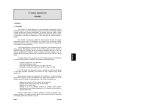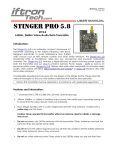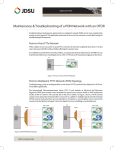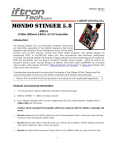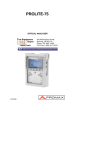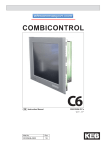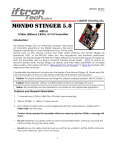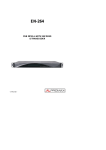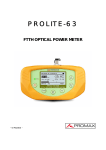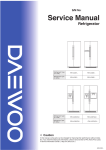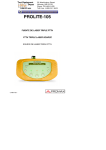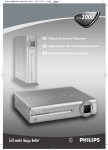Download GV-298 Manual
Transcript
TV PATTERN GENERATOR GV-298 1 GENERAL 1.1 Description The exceptional attributes the GV-298 video generator consists of have been designed in accordance with the latest trends of modern technology. Its application field is ranging to every use in which a professional feature is requested, such as to achieve the hardest requirements both in the synchronism step, and the colour and radiofrequency ones. User-friendly, compact and strong, the GV-298 is a specified tool for all servicing needs. The GV-298 will become a consummate partner for after-service professionals, both in workshop tasks and home repairs and fittings. Eight different pattern charts are available, allowing essential settings to be made in any television receiver, as well as to detect abnormalities through a visual picture examination. Besides, these equipment builts in four additional functions, to be connected or disconneted at will in every chart. This monitoring affects picture interlacing, chroma subcarrier, sound and PAL commutation. The synthesized RF modulator ranges from 37 MHz to 865 MHz, so any defect in tuning circuits or in the IF of the receiver can be detected. Tuning is performed by channel (CCIR, OIRT or FCC channes, depending on version), or directly by frequency in 50 kHz steps. A two-cell attenuator allows up to a maximum of 60 dB to be attenuated in 20 dB steps. A microcontroller carries out the interaction with the user, by displaying chart, channel and frequency (5-digits) at any time, on a 16-character display. Data displayed may be changed in an easy way by means of three pushbuttons. In order to increase quality and reliability of the GV-298, the built-in microprocessor carries out a checking of several equipment devices during its connection and use. An Euroconnector is included, as well as an oscilloscope synchronizing output. This equipment is intended for covering B, G and H standards (CCIR). Versions are available too for I, DK and N systems. 09/96 GV-298 - 32 - 1.2 Specifications TV SYSTEM System RF standard Line frequency Frame frequency CCIR PAL B, G, H (DK, I, N on request) 15625 Hz 50 Hz Horizontal synchronism Line period Previous pedestal Synchronism Blanking 64 µs 1.5 µs 4.7 µs 12 µs Vertical synchronism Frame period Blanking Pulse time of: - Pre-equalizing - Equalizing - Post-equalizing Frame sweep Colour subcarrier Subcarrier frequency Burst duration Burst position Phase Amplitude error Phase error Subcarrier amplitude Residual subcarrier DISPLAY 09/96 ± ± ± ± 0.0002 µs 0.3 µs 0.2 µs 0.3 µs 20 ms 25 H + 12 µs (H = 64 µs) 2.5 H 2.5 H 2.5 H Selectable: - 2:1 interlaced ratio No interlaced F=4.3361875 MHz <±30 ppm PAL B,G,H, DK,I. F=3.582056 MHz <± 30 ppm PAL N (10 ºC to 40 ºC). 2.5 µs (10 ± 1 F period) At 5.6 µs from the line previous synchronism flank. 135º as referred to U axis at the following sequence: Line Frame Even Odd 1 2 3 4 - - ++ ++ - - ± 5% ± 3º ON/OFF, selectable 3% (as related with red colour amplitude, 100% saturated). Digital, 16 characters, 5-digit frequency display, channel, TV standard, programme, pattern chart and sound system. GV-298 - 33 - TEST PICTURES Pattern charts available 1.2.3.4.5.6.7.8.- 8 100% white pattern Electronic circle grid Dots Checkboard Colour bars Red pattern Green pattern Blue pattern Anti-PAL pattern by removing the R-Y switching RADIOFREQUENCY OUTPUT Range Tuning Output amplitude Attenuator Output impedance Connector STABILITY At constant temperature At temperature From 37 to 865 MHz (synthesized) By frequency: in 50 kHz steps By channel: CCIR (OIRT version /2, FCC version /6). 80 dBµV ± 3.5 dB 0-60 dB in 20 dB steps 75 Ω BNC <1.2 x 10-3 /10 min. (the first 15 min.) <4 x 10-4 /10 min. (during the first hour) <1 x 10-4 /ºC (5 to 40 ºC) FREQUENCY INDICATOR Indicator Resolution In the 5-digit LCD display 50 kHz VIDEO MODULATION Modulation type Modulation index Video/sound ratio AM, double side band ~ 85% 13 dB SOUND MODULATION Carrier frequency Modulation type Drift 5.5 MHz, ON/OFF selectable FM 30 kHz MODULATION SIGNAL Internal Frequency 1 kHz ± 10% COMPOSITE VIDEO SIGNAL Amplitude Bias Output impedance Connector 1 Vpp Positive 75 Ω BNC and EUROCONNECTOR 09/96 GV-298 - 34 - R-G-B OUTPUTS Amplitude Output impedance Connector 0.7 Vpp 75 Ω EUROCONNECTOR TRIGGER OUTPUT FOR OSCILLOSCOPE Vertical + Horizontal Signal 2 Vpp vertical Amplitude 1.5 Vpp horizontal 5 kΩ Output impedance BNC Connector LOW FREQUENCY OUTPUT Amplitude Frequency Output impedance Connector 250 mVpp 1 kHz 10 kΩ EUROCONNECTOR POWER SUPPLY Mains voltage Consumption 110-125-220-230/240 V AC ± 10%/50-60 Hz 8W OPERATING ENVIRONMENT CONDITIONS 2000 m Max. altitude From 5 ºC to 40 ºC Temperature range 80% (up to 31 ºC), decreasing lineally up to 50% Max. relative humidity at 40 ºC. PHYSICAL FEATURES Dimensions Weight W.102 x H.90 x D.241 mm 2.250 kg ACCESSORIES INCLUDED 90901207 BNC/TV coaxial cable, CC-07 90901105 Mains cable, CA-05 Spare fuse, 5 x 20 mm, 250mA, F, 250V VERSIONS GV-298 GV-298/2 GV-298/4 GV-298/6 09/96 PAL PAL PAL PAL B, G, H. CCIR channels DK. OIRT channels I. CCIR channels N. FCC channels GV-298 - 35 - 2 SAFETY RULES * This is a class I equipment, for safety reasons plug it to a supply line with the corresponding ground terminal. * Use this equipment only with systems or devices with the negative measuring connected at ground potential or insulated from the mains. * This equipment can be used in Category II Instalations and Pollution Degree 1 environments. * When using some of the following accessories use only the specified ones to ensure safety. Power cord * Observe all specified ratings both of supply and measurement * Remember that voltages higher than 60V DC or 30V AC rms are dangerous * Use this instrument under the specified environmental conditions * The user is only authorized to carry out the following maintenance operations: Replace the mains fuse of the specified type and value On the Maintenance paragraph the proper instructions are given. Any other change on the equipment should ve carried out by qualified personnel. * The measuring negative is at ground potential. * Follow the cleaning instructions described in the Maintenance paragraph 09/96 GV-298 - 36 - * Symbols related with safety: DIRECT CURRENT ALTERNATING CURRENT DIRECT AND ALTERNATING GROUND TERMINAL PROTECTIVE CONDUCTOR FRAME TERMINAL EQUIPOTENTIALLITY ON (Supply) OFF (Supply) DOUBLE INSULATION PROTECTED (Class II Protection) CAUTION (Risk of electric shock) CAUTION REFER TO ACCOMPANYING DOCUMENTS FUSE 09/96 GV-298 - 37 - 3 INSTALLATION 3.1 Power requirements This equipment requires a mains power source of 110-125-220 or 230/240 V AC 50 to 60 Hz. Mains operating voltage can be selected at the rear panel. Figure 1.- Selection of mains voltage. 1.- Pull out the fuseholder lid. 2.- Set the proper fuse for the desired mains voltage. 3.- Insert the fuseholder lid so the [ A ] pointer faces the desired mains voltage display [ B ]. 09/96 GV-298 - 38 - CAUTION: THE EQUIPMENT IS FACTORY SET FOR 220 V OPERATING VOLTAGE. BEFORE SWITCHING ON THIS INSTRUMENT, SET THE VOLTAGE SELECTOR TO THE PROPER POSITION AND BE SURE THAT THE FUSE VALUE IS CORRECT. FUSE TYPE SHOULD BE: 5 x 20 mm., 250 V, F, and: 250 mA FOR ALL VOLTAGES AVOIDING THIS DIRECTIONS COULD DAMAGE THE EQUIPMENT 3.2 Installation This unit is ready to be used as a desk-top equipment. 09/96 GV-298 - 39 - 4 OPERATING INSTRUCTIONS 4.1 Description of controls Figure 2.- Front panel. [1] LINE . Mains switch. [2] LCD display. This display shows pattern chart selected, channel and frequency. In the event of a malfunction, this part will display an error code. [3] PAT. This area is designed for chart displaying. The several charts are specified by a letter, as drawn on the front panel. [4] Chart selection LED indicator. When this LED is on, the selected chart can be changed by pressing key [12] 09/96 (increase) or [13] (decrease). GV-298 - 40 - [5] CHAN. Display area designed for showing that channel tuned. When the selected frequency does not belong to any channel as implemented in the equipment, this area is blank. TV channels are designated with a "C" and a number; for instance, channel 41 is "C41". Cable TV channels are designated with an "S"; say "S11". (Implemented channels depend on version chosen). [6] Channel selection LED indicator. When this LED is on, the selected channel can be changed by pressing key [12] (increase) or [13] (decrease). [7] FREQ. MHz. Display area designed for showing frequency. Frequency is displayed with 5 digits, two of which are decimals. [8] Frequency selection LED indicator. When this LED is on, frequency tuned can be changed by pressing key [12] steps of 50. [9] (decrease), in ---40 dB attenuating cell. On pressing this key, a ---40 dB attenuation is entered in the radiofrequency output RF 75Ω [10] (increase) or [13] [11]. ---20 dB attenuating cell. On pressing this key, a ---20 dB attenuation is entered in the radiofrequency output RF 75Ω [11]. [11] . Modulated radiofrequency output. Composite video signal RF 75 Ω modulates the radiofrequency (RF) carrier in negative amplitude and at double side band. Impedance is 75 Ω. [12] Increasing key display [2]. . The next information is shown in the active area of the [13] Decreasing key display [2]. . The former information is shown in the active area of the [14] SEL. Selection key to select the display active area [2]. Upon selecting the active area, the displayed current information can be changed by pressing key [12] [15] (increase) or [13] (decrease). SOUND . This key enables the sound subcarrier. On pressing this key, the sound subcarrier comes out, frequency-modulated by a 1 kHz signal. NOTE: Low frequency signal in pins 1-3 of the EURO-AV [21] Euroconnector is unable to be removed, because the SOUND key [15] acts on the carrier only. [16] INTERLACED . On pressing this key, the interlacing is removed. [17] PAL. PAL switching suppression key. On pressing this key, that typical PAL system R-Y signal is removed. 09/96 GV-298 - 41 - [18] CHROMA. Colour subcarrier suppression key, to remove colour subcarrier fully. [19] VIDEO 75 Ω 1 Vpp . Composite video output with 1 Vpp amplitude and positive bias. Output impedance is 75 Ω. Figure 3.- Rear panel. [20] Mains input set [21] EURO-AV . Euroconnector [22] TRIG.SCOPE . Composite signal output for trigger oscilloscope 4.2 Start-up Once mains voltage to be used has been selected (point 3.1), the unit can be switched to mains and started up by pressing the LINE switch [1]. 09/96 GV-298 - 42 - 4.3 Using the equipment This section explains how to use the GV-298, including keyboard operation, composite video signal, radiofrequency, error messages; information appearing on the display is detailed as well. 4.3.1 Display and keyboard Figure 4 Depending on information shown, the display [2] may be divided in three areas. The first area PAT. [3] displays that pattern currently operating. Value shown in this area is any one of those letters specifying the pattern charts, as drawn on the GV-298 front panel. The second area CHAN. [5] displays the channel tuned. If a selected frequency does not belong to any channel implemented in the equipment, this area is blank. Otherwise, the number of the channel tuned is displayed. Finally, the third area FREQ. MHz. [7] is designed to display the tuned frequency (in MHz), with 5 digits, two of which are decimals. 09/96 GV-298 - 43 - A LED is provided just under each of these three areas described. Function of key SEL [14] is to enable one among these LED every time it is pressed. In this way, by pressing it recurrently, LED are lighted on sequentially. The enabled LED shows which display area is active, i.e., the current information can be changed by pressing key [12] (decrease). (increase) or [13] 4.3.2 Output signal In using the GV-298, two different ways may be discerned; a. Use of the composite video signal b. Use of the radiofrequency (RF) stage All parameters adjusted for the composite video signal are valid for the modulated RF signal. Current R, G and B signals in the EURO-AV Euroconnector [21] have fixed amplitude. These outputs cannot be used for analyzing the Anti-PAL signal, since it is a natural characteristic of this signal that it affects the colour subcarrier. CAUTION To achieve a right operation of the GV-298 when an output is connected to an external unit, make sure impedances are suited correctly as specified in point 1.2. Otherwise, a wrong operation could be noticed. 4.3.3 Pattern selection To select a pattern, the PAT. [4] chart selection indicator LED should be enabled. To this end, press key SEL [14] sequentially. Next to, that letter suiting with the required chart will be displayed, by pressing pushbuttons [12] [13] (increase) or (decrease). 4.3.4 Test pictures application Patterns are assembled in two rows, showing affinity in use. - 09/96 Top row: including four patterns intended for adjusting B/W parameters. A.- 100% white screen: Checkup of the beam current limiter circuit. Video recorders modulation adjustment and signal-to-noise ratio measurements. B.- Circle grid: Adjustment of static and dynamic convergency. Interlacing checkup. Adjustment of aspect ratio and picture centering in the screen. Adjustment of picture geometry and linearity through the electronic circle. C.- Dots: Focus voltage adjustment. GV-298 - 44 - D.- Checkboard: Video amplifier response analysis at low frequencies. A white level pulse is yield by all pattern charts, just before the previous sweep pedestal. This component allows video signals to be surveyed through the oscilloscope, as the line change is displayed just at the time it arises. This pulse cannot be seen in a conventional receiver, for it is hidden behind the right side of the screen. - Bottom row: including four patterns intended for adjusting the colour stage. E.- 100% white bars: Checkup of colour matrix, saturation, etc. F.- Red screen: Purity control of red colour (R), noise and beam current. G.- Green screen: Purity control of green colour (G), noise and beam current. H.- Blue screen: Purity control of blue colour (B), noise and beam current. 4.3.5 Function keys Keys [15] to [18] allow some pattern capability to be extended in order to enlarge their application field. Specification of these additional functions follows: [15] SOUND: This key enables the sound subcarrier. On pressing it, the sound subcarrier is frequency modulated by a 1 kHz signal. This subcarrier frequency varies depending on which system the GV-298 has been fitted for: 5.5 MHz for PAL B, G and H (GV-298 ground version), 6 MHz for PAL I (GV-298/4 version), 6.5 MHz for PAL DK (GV-298/2 version) and 4.5 MHz for PAL N (GV-298/6 version). NOTE: Low frequency signal in pins 1-3 of the EURO-AV [21] Euroconnector is unable to be removed, because the SOUND key [15] acts on the carrier only. 09/96 [16] INTERLACED: Interlacing cancellation. This function is useful when adjusting convergencies. In the grid pattern, horizontal lines are shaped by two white lines; one from the even frame, the other from the odd one. If this pattern is watched from a close position to the screen, flickering is very pronounced. Thence, user would have it easier to remove interlacing; in this way, that flickering is removed too. Besides, interlacing suppression allows the vertical integration system of the synchronism separator to be verified. [17] PAL: In a standard operation of a colour pattern, the GV-298 will transmit component +(R-Y) and +(B-Y) in one line, and component -(R-Y) and +(B-Y) in the next line; i.e., signal (R-Y) is switched in each line, but component (B-Y) is kept constant. This process concerns both chroma vectors and burst, which is eventually telling the receiver how to switch the (R-Y) signal sensed, in order to retrieve the source colour signal. GV-298 - 45 - On pressing key PAL, (R-Y) switching -PAL system typical- is suppressed. Anyhow, as the burst switching is kept, the receiver will perform the (R-Y) switching further. As a result, no signal at all will come out at the (R-Y) demodulator output if the receiver is adjusted correctly. On a properly adjusted TV set, lack of (R-Y) component can be observed in the colour bar signal picture without PAL switching. [18] CHROMA: The colour subcarrier may be suppressed fully. In this way, luminance can be analyzed in colour patterns. Lack of chroma in the transmitted signal shall enable the colour killer circuit of the receiver. Therefore, if a screen colouring appears in such conditions, it should be charged to a defective working in some stage or, in some cases, to a excess of gain of chroma amplifiers. 4.3.6 Radiofrequency stage Radiofrequency (RF) carrier is modulated by the composite video signal, in negative amplitude and double side band. This signal is available at the RF connector output [11]. Impedance is 75 Ω. Frequencies selected by the user are programmed into the RF unit by a microprocessor. Frequency tuned is displayed at any time. Tuning is performed in two ways, whether by channel, or by frequency directly. 4.3.6.1 Tuning by channel The GV-298 pattern generator is carrying out a great number of standard channels, easy to access through the keyboard. On pressing key SEL [14] repeatedly, the CHAN [6] LED indicator will light on. In this condition, the display shows "C?" (channel may be changed). Increasing [12] key or decreasing key [13] are used for channel varying. The selected channel will then be displayed, together with its frequency. The following table lists both channels, frequency ranges and TV bands assigned. (Ground version, CCIR channels). 09/96 GV-298 - 46 - Band Frequency range Channels IF 38.9 MHz IF IB 47 - 65 MHz 2-4 MIDDLE 104 - 174 MHz S1 - S10 B III 174 - 230 MHz 5 - 12 SUPER 230 - 300 MHz S11 - S20 HYPER 302 - 468 MHz S21 - S41 B IV 470 - 606 MHz 21 - 37 BV 606 - 854 MHz 38 - 69 NOTE: "S" channels are used for cable TV signals transmission. 4.3.6.2 Tuning by frequency Within the frequency range of the equipment (37 MHz to 865 MHz), any frequency may be tuned in 50 kHz steps. In this way, any tuning may be approached, even if it does not belong to any specified channel. On pressing key SEL [14] sequentially, the FREQ. MHz [8] indicator LED will light on. Next to, frequency to be tuned can be modified by using keys [12] (increase) or [13] (decrease). When the tuned frequency matches a channel, the display will read the number and type of that channel. In the event that tuned frequency does not match any channel as specified by the equipment, no indication will be displayed. Since the modulation system is using a double side band, two apparently right tuning points can be found. This does not happen on tuning a TV station, as system used is a partially suppressed lower side band. In order to decide which from the two points is the right one, this suits with the higher frequency, if tuning is done with a TV set. On the contrary, it suits with the lowest frequency, when tuning through the generator. 4.3.6.3 RF signal attenuation To check automatic gain control circuits of TV sets, a two-cell (one ---20 dB cell and one ---40 dB cell) attenuator has been built in, in order to attenuate the RF output, if required. Maximum total attenuation is ---60 dB, in ---20 dB steps. 09/96 GV-298 - 47 - dB ATTENUATION CELLS ENABLED 00 20 40 60 None 20 key [10] pushed 40 key [9] pushed 20 + 40 keys [10] and [9] pushed With a ---40 dB (300 µV) attenuation, a properly adjusted TV set usually shows a snow effect picture. 4.3.6.4 Intermediate frequency Intermediate frequency used in TV sets is 38.9 MHz. In the GV-298, this carrier is achieved by selecting a channel (see 4.3.6.1), or a frequency (see 4.3.6.2). Intermediate frequency tuning by channel requires moving towards that first expected channel, just before C02. Then, the display will show "IF", together with frequency related to. This configuration allows a modulated signal to be supplied to the I.F. stage input of the receiver. This signal may be used to check whether the noticed failure is due to the tuner or to a later stage. 4.3.7 Error messages The GV-298 builds in a microcontroller ready to detect a defective running of some equipment devices. As soon as an abnormal behaviour is found, an error message is displayed in the following format: ERROR: XX Where XX is that number designing the kind of failure arisen, for instance: ERROR:00 An error message will vanish on pressing either key [12], [13] or [14]. If error persists, that warning will appear again while the equipment is running. In such a case, please contact your distributor, telling him the message shown by the GV-298. Every time the GV-298 is connected, the unit performs an AUTOTEST in order to check its proper operation. If an error is sensed, the display will show: "AUTOTEST FAILED", which means some failure is arising. In this case, like formerly, your distributor should be contacted. 09/96 GV-298 - 48 4.3.8 Output description 4.3.8.1 Composite video output Positive composite video signal can be drawn through connector BNC, [19] on the front panel, with 1 Vpp amplitude and 75 Ω output impedance. VIDEO This signal is very useful for checking video monitors (B/W and color), line amplifiers, VCR and any other equipment working with a composite video. CAUTION This signal should never be switched to voltage circuit points, but only on video signal standardized inputs with 75 Ω impedance. Damages arisen in the unit ensuing from neglecting this caution are not covered by warranty. 4.3.8.2 Euroconnector (EN50049 DIN connector) Generator GV-298 is provided with an EUROCONNECTOR type connector, also known as SCART connector or PERITEL connector (according to NF-C92250 standard). Output signals from this connector are: PIN NUMBER 1-3 4 5 7 8 9 11 13 15 17 19 21 SIGNAL 1 kHz sound output Sound ground Blue ground (B) Blue output (B) +12 V switching output Green ground (G) Green output (G) Red ground (R) Red output (R) Composite video ground Composite video output Connector shield ground Figure 5.- Description of EUROCONNECTOR switching pins For more information, see point 1.2 (Specifications). 4.3.8.3 Trigger oscilloscope When a TV set circuits are analyzed with the help on an oscilloscope, desynchronization due to amplitude differences of signals watched is not desirable, as is the case when synchronism is done internally. To get a quite synchronized picture, regardless of signal amplitude, the external synchronism input of the oscillospe should be used, connecting same to the TRIGG output of generator GV-298, connector [22]. If the oscilloscope has, as all PROMAX types have, a TV TRIG.SCOPE automatic filter connected to the time base switch, then passing from the horizontal frequency to the vertical one can be made without synchronism loss. In this output, horizontal pulses are mixed with higher amplitude vertical ones, thus providing the oscilloscope to be synchronized to vertical frequency. 09/96 GV-298 - 49 - 5 OPERATION PRINCIPLE This chapter is an overview of the GV-298 operation. Explanation lies in block diagram of Figure 6, at the end of this chapter. 5.1 Synchronism generator The synchronism generator supplies two significant signals in order to allow GV-298 output to be viewed through a TV set: these two signals are the horizontal and the vertical synchronisms. The first one commands a line changing in the TV set while the second one starts a screen sweep. 5.2 Control logic and colour generation This module generates a video signal according to the pattern selected, the function keys enabled and system chosen (PAL), giving rise to the three basic signals (R, G and B). From them, luminance is issued (identified as "Y" in the block diagram). R, G and B are carried to the colour module, which builds signals R-Y and B-Y. These are used to square-modulate the colour subcarrier, which frequency is settled by the system used. Video signal is generated from luminance and chrominance, by a submodule generator. This signal is carried through a stage in order to give a 75 Ω output impedance to the video signal. After crossing a suitable output stage, R, G and B signals are present in the EUROCONNECTOR. 5.3 Sound The low frequency oscillator generates a 1 kHz signal used for sound modulation. A carrier, frequency of which is specified by that standard used, is frequency modulated by the low frequency signal and carried to the RF unit. The 1 kHz signal is carried through an output stage, to fit it with a suitable impedance; then this signal is switched to the EUROCONNECTOR. 5.4 Radiofrequency unit Function of the radiofrequency unit is to modulate both video and sound signals with a user's selected frequency carrier. This unit is synthesized in order to ascertain a minimum drift in that signal supplied by the GV-298. An attenuation unit allows that level supplied by the RF unit to be varied in a 0 dB, 20 dB, 40 dB and 60 dB scale. 09/96 GV-298 - 50 - 5.5 Microcontroller This component operates interaction between the GV-298 and the user, directing the display and the keyboard. This microprocessor gives relevant commands to the RF unit and to the control logic module, in order to generate a suitable signal to user's requirements. 09/96 GV-298 - 51 - 09/96 GV-298 - 52 - 09/96 GV-298 - 53 - 6 MAINTENANCE 6.1 Replacing the mains fuse The fuseholder lid is placed in the mains base (see figure 1) and it is the voltage selector. To substitute the fuse, disconect the power cord. With an appropiate screw driver remove the fuseholder lid. Substitute the melt fuse for another of: FUSE TYPE SHOULD BE: 5 x 20 mm., 250 V, F, and: 250 mA FOR ALL VOLTAGES AVOIDING THIS DIRECTIONS COULD DAMAGE THE EQUIPMENT When inserting the fuseholder lid be careful that the voltage selector is in the correct position according to the mains. 6.2 Cleaning recommendations CAUTION To clean the cover, take care the instrument is disconnected CAUTION Do not use scented hydrocarbons or chlorized solvents. Such products may attack the plastics used in the construction of the cover. The cover should be cleaned by means of a light solution of detergent and water applied with a soft cloth. Dry thoroughly before using the system again. 09/96 GV-298 - 28 - 09/96 GV-298 - 29 - TABLE OF CONTENTS 1 GENERAL . . . . . . . . . . . . . . . . . . . . . . . . . . . . . . . . . . . . . . . . . . . . . . . . . . 1.1 Description . . . . . . . . . . . . . . . . . . . . . . . . . . . . . . . . . . . . . . . . . . . . . . 1.2 Specifications . . . . . . . . . . . . . . . . . . . . . . . . . . . . . . . . . . . . . . . . . . . . 31 31 32 2 SAFETY RULES . . . . . . . . . . . . . . . . . . . . . . . . . . . . . . . . . . . . . . . . . . . . . . 35 3 INSTALLATION . . . . . . . . . . . . . . . . . . . . . . . . . . . . . . . . . . . . . . . . . . . . . . 3.1 Power requirements . . . . . . . . . . . . . . . . . . . . . . . . . . . . . . . . . . . . . . . . 3.2 Installation . . . . . . . . . . . . . . . . . . . . . . . . . . . . . . . . . . . . . . . . . . . . . . . 37 37 38 4 OPERATING INSTRUCTIONS . . . . . . 4.1 Description of controls . . . . . . . . 4.2 Start-up . . . . . . . . . . . . . . . . . . . 4.3 Using the equipment . . . . . . . . . 4.3.1 Display and keyboard . . . . . 4.3.2 Output signal . . . . . . . . . . . 4.3.3 Pattern selection . . . . . . . . 4.3.4 Test pictures application . . . 4.3.5 Function keys . . . . . . . . . . . 4.3.6 Radiofrequency stage . . . . . 4.3.6.1 Tuning by channel . . . . 4.3.6.2 Tuning by frequency . . 4.3.6.3 RF signal attenuation . 4.3.6.4 Intermediate frequency 4.3.7 Error messages . . . . . . . . . 4.3.8 Output description . . . . . . . 4.3.8.1 Composite video output 4.3.8.2 Euroconnector . . . . . . 4.3.8.3 Trigger oscilloscope . . . . . . . . . . . . . . . . . . . . . . . . . . . . . . . . . . . . . . . . . . . . . . . . . . . . . . . . . . . . . . . . . . . . . . . . . . . . . . . . . . . . . . . . . . . . . . . . . . . . . . . . . . . . . . . . . . . . . . . . . . . . . . . . . . . . . . . . . . . . . . . . . . . . . . . . . . . . . . . . . . . . . . . . . . . . . . . . . . . . . . . . . . . . . . . . . . . . . . . . . . . . . . . . . . . . . . . . . . . . . . . . . . . . . . . . . . . . . . . . . . . . . . . . . . . . . . . . . . . . . . . . . . . . . . . . . . . . . . . . . . . . . . . . . . . . . . . . . . . . . . . . . . . . . . . . . . . . . . . . . . . . . . . . . . . . . . . . . . . . . . . . . . . . . . . . . . . . . . . . . . . . . . . . . . . . . . . . . . . . . . . . . . . . . . . . . . . . . . . . . . . . . . . . . . . . . . . . . . . . . . . . . . . . . . . . . . . . . . . . . . . . . . . . . . . . . . . . . . . . . . . . . . . . . . . . . . . . . . . . . . . . . . . . . . . . . . . . . . . . . . . . . . . . . . . . . . . . . . . . . . . . . . . . . . . . . . . . . . . . . . . . . . . . . . . . . . . . . . . . . . . . . . . . . . . . 39 39 41 42 42 43 43 43 44 45 45 46 46 47 47 48 48 48 48 5 OPERATION PRINCIPLE . . . . . . . . . . 5.1 Synchronism generator . . . . . . . . 5.2 Control logic and colour generation 5.3 Sound . . . . . . . . . . . . . . . . . . . . . 5.4 Radiofrequency unit . . . . . . . . . . . 5.5 Microcontroller . . . . . . . . . . . . . . . . . . . . . . . . . . . . . . . . . . . . . . . . . . . . . . . . . . . . . . . . . . . . . . . . . . . . . . . . . . . . . . . . . . . . . . . . . . . . . . . . . . . . . . . . . . . . . . . . . . . . . . . . . . . . . . . . . . . . . . . . . . . . . . . . . . . . . . . . . . . . . . . . . . . . . . . . . . . . . . . . . . . . . . . . . . . . . 49 49 49 49 49 50 6 MAINTENANCE . . . . . . . . . . . . . . . . . . . . . . . . . . . . . . . . . . . . . . . . . . . . . . 6.1 Replacing the mains fuse . . . . . . . . . . . . . . . . . . . . . . . . . . . . . . . . . . . . 6.2 Cleaning recommendations . . . . . . . . . . . . . . . . . . . . . . . . . . . . . . . . . . 53 53 53 09/96 GV-298

























